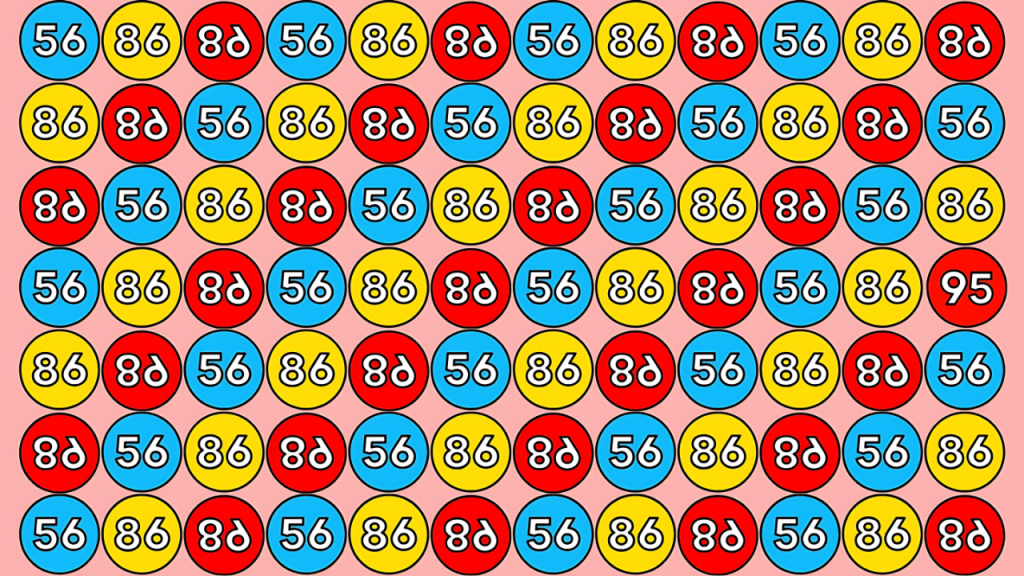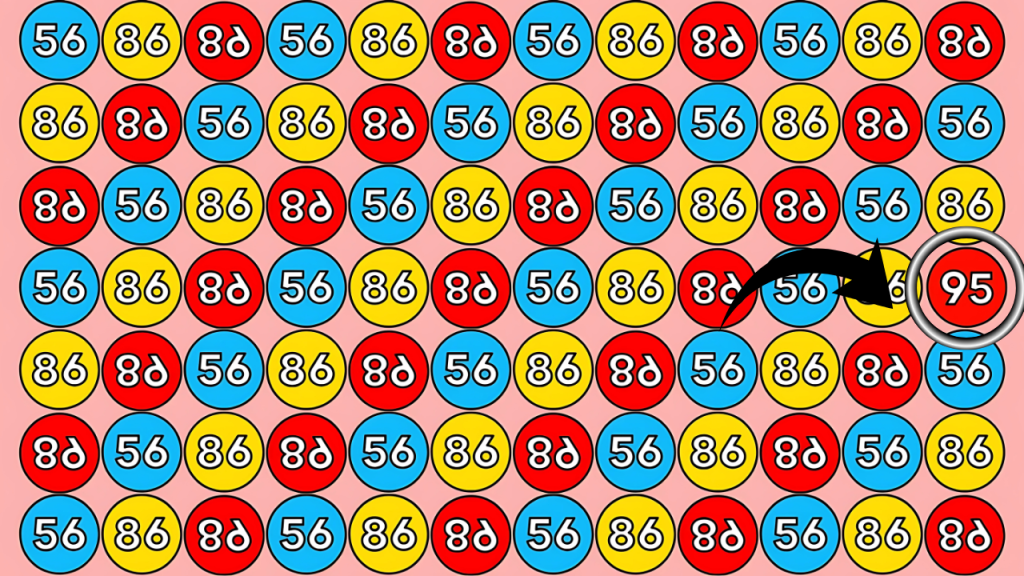Have you ever stared at something so long that your eyes started playing tricks on you? That’s exactly what happens with today’s mind-bending challenge. This particular optical illusion has been making rounds on social media, leaving people both frustrated and fascinated.
The task seems deceptively simple on paper. You just need to find the number 95 hidden among a sea of 56s, 86s, and upside-down 68s. But here’s the kicker – you’ve only got 6 seconds to spot it!
Most folks end up scratching their heads in confusion. The colorful arrangement of numbers creates a perfect camouflage that tricks your brain into overlooking the odd one out.
Why Optical Illusions Fascinate Us
Optical illusions have captivated human curiosity for centuries. They exploit the gap between what our eyes see and how our brain interprets that information.
Ever noticed how time seems to slow down when you’re fully engrossed in a challenging puzzle? That’s your brain firing on all cylinders, desperately trying to make sense of conflicting visual information.
These visual puzzles aren’t just entertaining time-killers. They actually serve as excellent brain exercises that sharpen your cognitive abilities and improve your attention to detail.
Researchers have found that regularly engaging with optical illusions can boost your problem-solving skills. They force your mind to think outside the conventional patterns it’s used to following.
The Science Behind the Confusion

What makes this particular number-spotting challenge so tricky? It all comes down to something scientists call “visual grouping.”
When presented with similar-looking objects, our brains automatically group them together. This mental shortcut usually helps us make sense of our complex visual world without getting overwhelmed.
But in this case, that same helpful mechanism works against us. The numbers 56, 86, and the inverted 68 share similar curves and shapes, making the different number 95 blend perfectly into the background.
The bright colors used in the image further complicate things. They deliberately distract your attention from focusing on the individual shapes of the numbers.
Your brain gets caught up trying to process all the visual noise. Meanwhile, the 6-second countdown adds pressure that makes clear thinking even harder.
Training Your Brain to See Differently
So how can you improve your chances of spotting the hidden number? The trick lies in developing a systematic scanning technique rather than randomly darting your eyes across the image.
Start from one corner and methodically work your way across the puzzle. Don’t let your gaze jump chaotically from one spot to another – that’s exactly how you miss the target.
Another helpful strategy involves defocusing your vision slightly. Sometimes, looking at the image with a softer focus allows patterns to emerge that weren’t visible when staring intensely.
Regular practice with similar puzzles can dramatically improve your performance. Your brain gradually learns to recognize and ignore distractions while zeroing in on what’s different.
The Hidden Benefits of Visual Puzzles
These fun challenges offer more than just a quick dopamine hit when you solve them. They provide some surprising health benefits that might make you want to incorporate them into your daily routine.
For starters, optical illusions serve as excellent stress relievers. The brief but complete immersion in a puzzle gives your mind a break from worrying about deadlines, responsibilities, and other sources of anxiety.
They also help improve your visual memory – a skill that comes in handy in countless everyday situations, from remembering where you parked your car to recalling important details from a presentation.
Parents and educators have long recognized the value of these puzzles for children’s development. They help kids learn to focus their attention and think critically from an early age.
Even doctors sometimes use specialized optical illusions as diagnostic tools. Certain visual perception tests can help identify neurological conditions affecting how the brain processes visual information.
Optical Illusion Answer

How This Particular Challenge Tests Your Brain
The “Find the 95” challenge targets several specific cognitive abilities. Understanding which mental muscles you’re flexing might make the experience more rewarding.
First, it tests your selective attention – the ability to focus on relevant information while filtering out distractions. The sea of similar numbers acts as the perfect distraction.
Second, it challenges your pattern recognition skills. Your brain needs to quickly establish what pattern the majority of numbers follow, then identify the exception to that pattern.
Third, it measures your processing speed – how quickly your neural pathways can transmit and interpret visual information. The 6-second time limit makes this aspect particularly challenging.
Finally, it gauges your visual discrimination abilities – how well you can detect subtle differences between similar objects. The similarity between 95 and the other numbers puts this skill to the ultimate test.
Ready for the Solution?
If you’ve been puzzling over the image without success, don’t worry – you’re definitely not alone! Many people need several attempts before they spot the elusive number 95.
The sneaky number 95 hides in the bottom-right section of the image. It blends in beautifully with its surroundings, which explains why so many people overlook it on their first few passes.
Did you find it within the 6-second limit? If so, give yourself a pat on the back! Your visual processing abilities are sharper than average.
If it took you longer, that’s perfectly fine too. These challenges are meant to be fun, not stressful assessments of your cognitive abilities.
What Your Performance Reveals
The time it takes you to spot the hidden number can offer interesting insights into how your brain processes visual information. Though not scientifically rigorous, these observations can be quite revealing.
Those who find the number within 3 seconds often possess extraordinary visual processing speed. Their brains quickly parse complex visual scenes and identify anomalies with remarkable efficiency.
If you spotted it between 4-6 seconds, you have above-average visual attention skills. Your brain methodically processes visual information at a good pace without missing important details.
Taking 7-15 seconds indicates normal visual processing abilities. Most people fall into this category, efficiently sorting through visual information at a steady pace.
Needing more than 15 seconds might suggest your brain prefers thoroughness over speed. You process visual details carefully rather than rushing to conclusions – a valuable trait in many situations!
Create Your Own Challenge
Enjoyed this brain teaser? Why not create similar challenges for friends and family? It’s easier than you might think to craft your own optical illusions.
Start with a grid of similar numbers or symbols. Then, subtly insert one different element that follows the same basic shape pattern but differs in a small but crucial way.
Add some colorful backgrounds to increase the difficulty level. Bright colors distract the brain and make the task of spotting differences significantly more challenging.
Set a time limit that’s just short enough to add some pressure without making the challenge impossible. The sweet spot is usually between 5-10 seconds, depending on the complexity.
Share your creation on social media and watch as friends and family struggle with your fiendish puzzle! There’s something strangely satisfying about creating a challenge that stumps others.
Beyond Number Puzzles
The world of optical illusions extends far beyond simple number-spotting challenges. If you enjoyed this brain teaser, there’s a whole universe of visual puzzles waiting to be explored.
Classic illusions like the Necker cube or the rabbit-duck drawing demonstrate how our brains can interpret the same image in multiple ways. They highlight the constructive nature of visual perception.
Motion illusions create the impression of movement in completely static images. They exploit specific properties of our visual system to create convincing impressions of spinning, expanding, or flowing.
Color illusions show how context dramatically affects our perception of colors. The same shade can appear completely different depending on the surrounding colors – a powerful reminder that perception isn’t always reality.
Size illusions demonstrate how our brains judge the dimensions of objects relative to their surroundings. They explain why the moon appears larger near the horizon than when high in the sky.
Whether you spotted the number 95 in record time or took a bit longer, these visual challenges offer a fun way to exercise your brain. They remind us that seeing isn’t just about having functional eyes – it’s about how our brains interpret what we see.
Next time you come across an optical illusion or visual puzzle, don’t just scroll past it. Take a moment to engage with it, knowing that you’re giving your brain a beneficial workout while having fun.
Challenge yourself regularly with different types of visual puzzles. The more diverse the challenges, the more comprehensive the cognitive benefits you’ll reap.
Remember that the goal isn’t always to be the fastest. Sometimes, taking your time and truly appreciating the cleverness of the illusion can be just as rewarding as quickly spotting the solution.
So, how did you do with the 95 challenge? Whether you’re celebrating your visual prowess or vowing to improve with practice, keep enjoying these mind-bending puzzles!
Frequently Asked Questions
What makes optical illusions so challenging for our brains? Optical illusions exploit the gap between what our eyes see and how our brain interprets that information, creating conflicts that confuse our normal visual processing.
Are optical illusions good for brain health?
Yes, regularly engaging with optical illusions can improve cognitive abilities like attention to detail, pattern recognition, and visual processing speed.
Why do some people spot hidden elements faster than others?
Individual differences in neural processing speed, attention patterns, and visual discrimination abilities all contribute to how quickly someone can solve visual puzzles.
Can practicing optical illusions improve my focus?
Absolutely! These puzzles train your brain to ignore distractions and focus selectively on important visual information.
Are there any practical applications for optical illusions?
Yes, they’re used in various fields including neurology (as diagnostic tools), education (for cognitive development), art (for aesthetic effects), and even marketing (to attract attention).
Do optical illusions work differently for different age groups?
Yes, visual processing abilities develop throughout childhood and typically peak in early adulthood before gradually declining with age, affecting how different age groups perceive illusions.
Can optical illusions cause eye strain?
Intense focus on complex illusions for extended periods might cause temporary eye fatigue, but taking regular breaks can prevent this issue.
Are there cultural differences in how people perceive optical illusions?
Some research suggests that cultural backgrounds can influence certain aspects of visual perception, potentially affecting how people interpret certain types of illusions.
